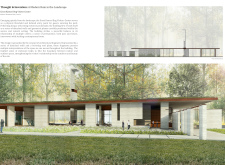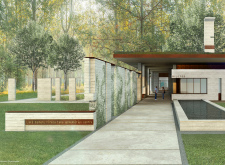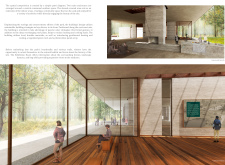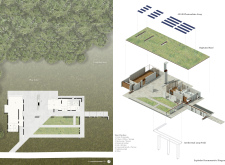5 key facts about this project
The Great Kemeri Bog Visitor Center is located in Kemeri National Park, Latvia, serving as an important entry point and a space for visitors to engage with the natural surroundings. The design reflects a concept of fragmentation, using various detached walls and geometric shapes to interact with the landscape. This approach creates a link between the constructed environment and nature, inviting exploration and interaction.
Design Concept
The idea of fragments shapes both the form and function of the building. Rather than appearing as a single structure, the visitor center unfolds gradually, guiding guests along an entrance promenade. This pathway enhances the experience by revealing different aspects of the architecture and surrounding environment. Visitors are encouraged to explore the transition from the natural bog to the constructed spaces they encounter.
Spatial Organization
The layout of the visitor center is centered around a clear plan, featuring two main enclosures arranged around a central outdoor area. This communal space acts as an extension of the indoors, promoting various activities for visitors. The design encourages community interaction while maintaining a strong connection to the park's diverse ecosystems, allowing guests to appreciate the rich environment around them.
Sustainability Strategies
Sustainability is a key focus of the visitor center's design. The building is oriented to take advantage of natural sunlight while minimizing the need for heating and cooling systems. A deep overhanging roof helps prevent excessive solar heat gain, contributing to energy efficiency. The choice of local and durable materials emphasizes a connection to the surrounding landscape, supporting the project's commitment to responsible building practices.
Educational Features
Inside the visitor center, the Exhibition Room serves as a space for learning about the ecology and history of the park. Large windows provide views of the landscape, creating a connection between the interior and the natural world outside. This design encourages visitors to engage with the park’s unique features and history, enriching their overall experience.
The fragmented walls invite light and create areas of shelter, offering a balance between enclosure and openness. This thoughtful design detail fosters a sense of welcome and encouragement for visitors to explore both the architecture and the beauty of the surrounding area.





















































